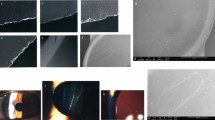A modified double torsion test has been developed to measure the fracture toughness of polymeric ophthalmic lenses. Measurements on PMMA sheet using both conventional double torsion and compact tension geometries gave the same fracture toughnesses as lenses made from the PMMA sheet and tested in the modified double torsion test. Tests on plano lenses made of commercial ophthalmic lens materials showed that the measured fracture toughness was independent of lens diameter and thickness and also crack length provided the notch length was within specified bounds. Test results showed quite small scatter. Because of the reproducibility and simplicity of the test, the modified double torsion test should provide a more reliable and cheaper measure of the impact performance of the lenses than does the existing drop weight test.
Similar content being viewed by others
References
ASTM D 3029-90, 1991 Annual Book of ASTM Standards, 8.02 Plastics (ii), 1991.
ASTM E 399, 1991 Annual Book of ASTM Standards, 3.01 Metals: Mechanical Testing, 1991
E.Plati and J. G.Williams, Polym. Eng. Sci. 15 (1975) 470.
H. R.Brown, J. Mater. Sci. 8 (1973) 941.
J. G.Williams, “Fracture mechanics of polymers” (Ellis Horwood, England, 1984).
R. M.Anderson, Advanced Materials and Processes 135 (3) (1989) 31.
N. V.Novikov, S. N.Dub and S.IBulychov, Zavodskaya Laboratoriya 54 (7) (1988) 60.
W.Young, “Roarke's formulas for stress and strain” (McGraw-Hill, New York, 1989) p. 477.
D. P.Rooke and D. J.Cartwright, “Compendium of stress intensity factors” (Her Majesty's Stationery Office, London, 1974), p. 297.
A. J.Evans, Int. J. Fracture 9 (1973) 267.
D. C.Phillips and J. M.Scott, J. Mater. Sci. 13 (1978) 311.
R. J.Young and P. W. R.Beaumont, J. Mater. Sci. 14 (1979) 1609.
J. O. Outwater, M. C. Murphy, R. G. Humble and J. T. Berry, “Fracture toughness and slow-stable cracking” (ASTM STP 559, 1974) p. 127.
J. A.Kies and A. B. J.Clark, in Proceedings of the 2nd International Conference on Fracture, Brighton, April 1969, edited by P. L.Pratt (Chapman and Hall, London, 1969) p. 483.
V. Z.Vlasov and U. N.Leont'ev, “Beams, plates and shells on elastic foundations” (Israel Program for Scientific Translations, Jerusalem, 1966) p. 184.
E.Kreyszig, “Advanced engineering mathematics” (Wiley, New York, 1983) p. 947.
Author information
Authors and Affiliations
Rights and permissions
About this article
Cite this article
McAuliffe, P.J., Truss, R.W. A modified double-torsion method for measuring the fracture toughness of polymeric ophthalmic lenses. J Mater Sci: Mater Med 5, 138–143 (1994). https://doi.org/10.1007/BF00053333
Received:
Accepted:
Issue Date:
DOI: https://doi.org/10.1007/BF00053333




